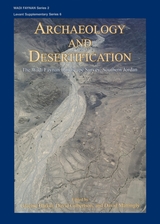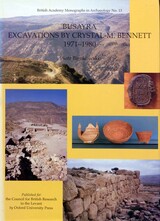25 books about Jordan

Archaeology and Desertification
The Wadi Faynan Landscape Survey, Southern Jordan
G. Barker
Council for British Research in the Levant, 2007
The Wadi Faynan is a harshly beautiful and desertic landscape in southern Jordan, situated between the hyper-arid deserts of the Wadi 'Arabah and the rugged and wetter Mountains of Edom. Archaeology and Desertification presents the results of the Wadi Faynan Landscape Survey, an inter-disciplinary study of landscape change undertaken in the Wadi Faynan by a team of archaeologists and geographers with the goal of contributing to present-day desertification debates by providing a long-term perspective on the relationship between environmental change and human history. The Wadi Faynan was the focus for some of the earliest farming in the Near East, and the earliest metallurgy, and in Roman times was a centre for copper and lead mining. The project reveals how past communities of farmers, shepherds, and miners managed their challenging environment, the solutions they developed, their successes and failures, and their short- and long-term environmental impacts. The richness of the palaeoclimatic, archaeological and palaeoecological data reveals an environmental/cultural history of complex pathways, synergies, and feedbacks operating at many different geographical scales, rates, and intensities. The project's findings on the complexity of past and present people:environment relations in the Wadi Faynan affirm the power of inter-disciplinary landscape archaeology to contribute significantly to the desertification debate. With global warming likely to threaten the lives of millions of people in the semi-arid and arid lands that comprise over a third of the planet through the course of this century, with potentially dire consequences for adjacent populations in better-watered regions, understanding the complexity of past responses to aridification has never been more urgent.
[more]

Busayra excavations by Crystal-M. Bennett, 1971-1980
Piotr Bienkowski
Council for British Research in the Levant, 2002
This volume is the long-awaited final report on the late Crystal Bennett's 1971-1980 excavations at Busayra, the major city of the Iron Age kingdom of Edom in southern Jordan. Dr. Bienkowski and specialist contributors describe and illustrate the architecture, stratigraphy, pottery and other finds of this impressive fortified administrative and religious center. The concluding chapter puts the nature and role of Busayra into its proper ancient context in the light of current research on tribal kingdoms.
Library of Congress subject headings for this publication:
Busayra Site (Bu�sayr�a, Jordan)
Excavations (Archaeology) -- Jordan -- Bu�sayr�a.
Iron age -- Jordan -- Bu�sayr�a.
Library of Congress subject headings for this publication:
Busayra Site (Bu�sayr�a, Jordan)
Excavations (Archaeology) -- Jordan -- Bu�sayr�a.
Iron age -- Jordan -- Bu�sayr�a.

